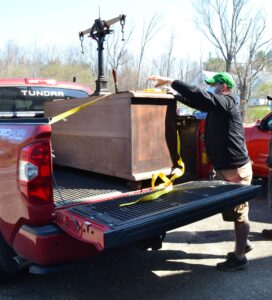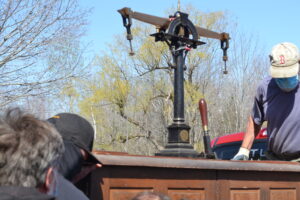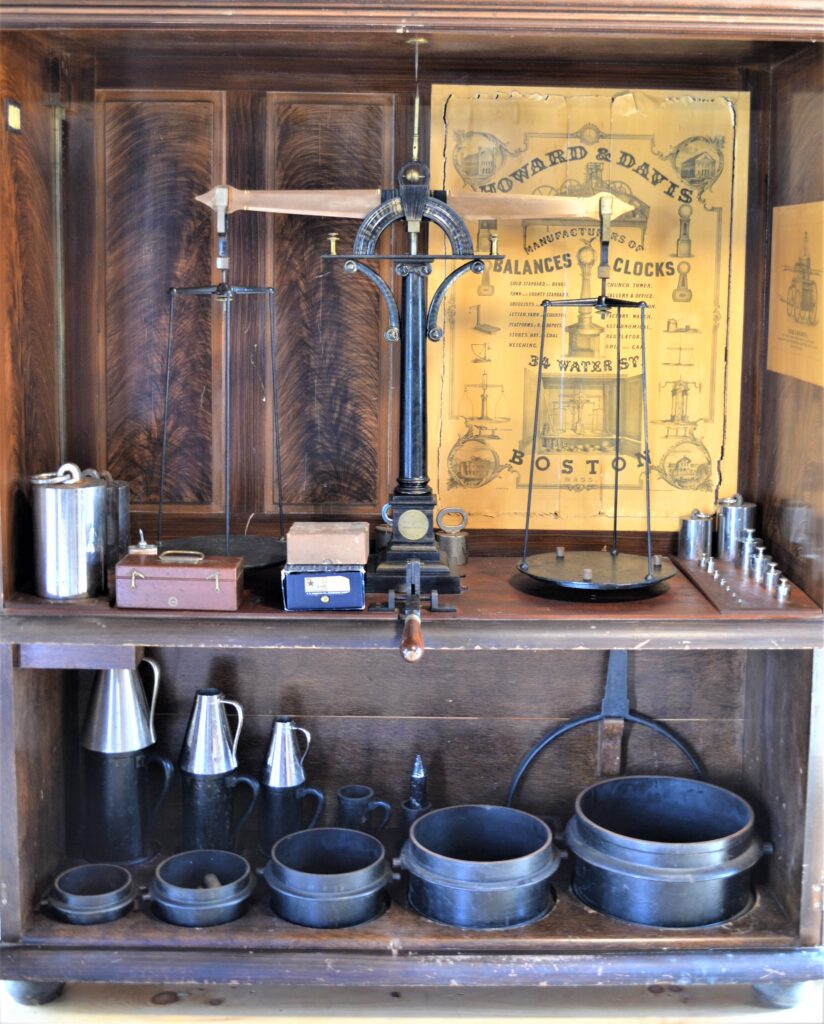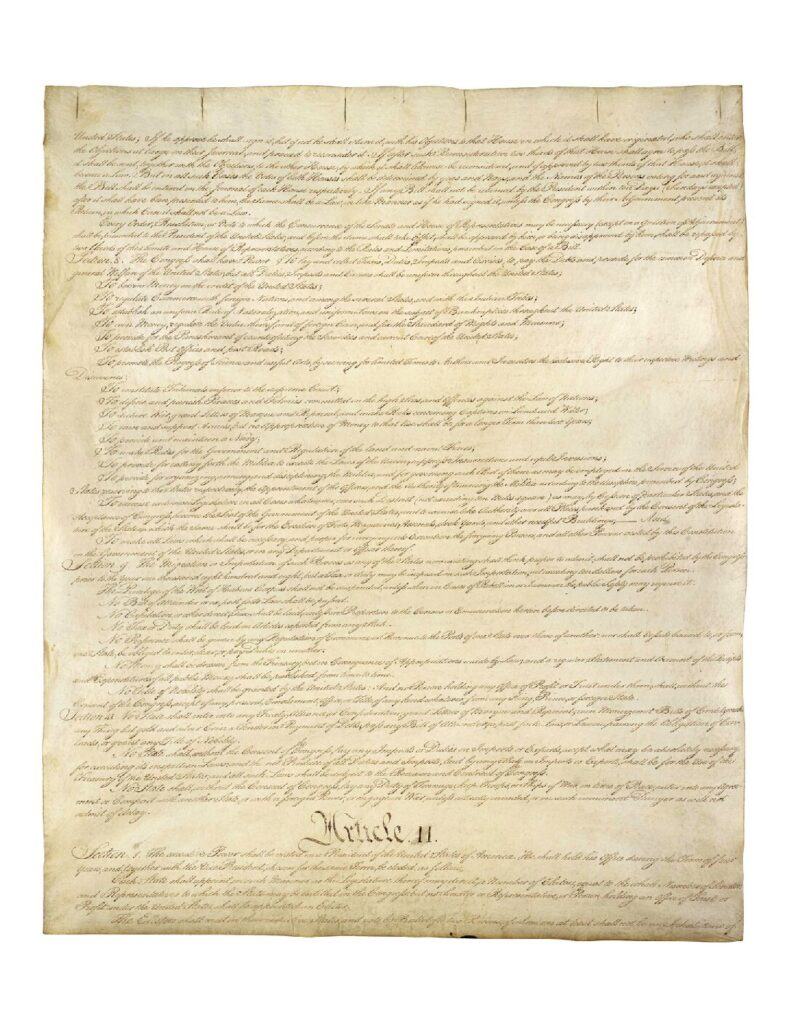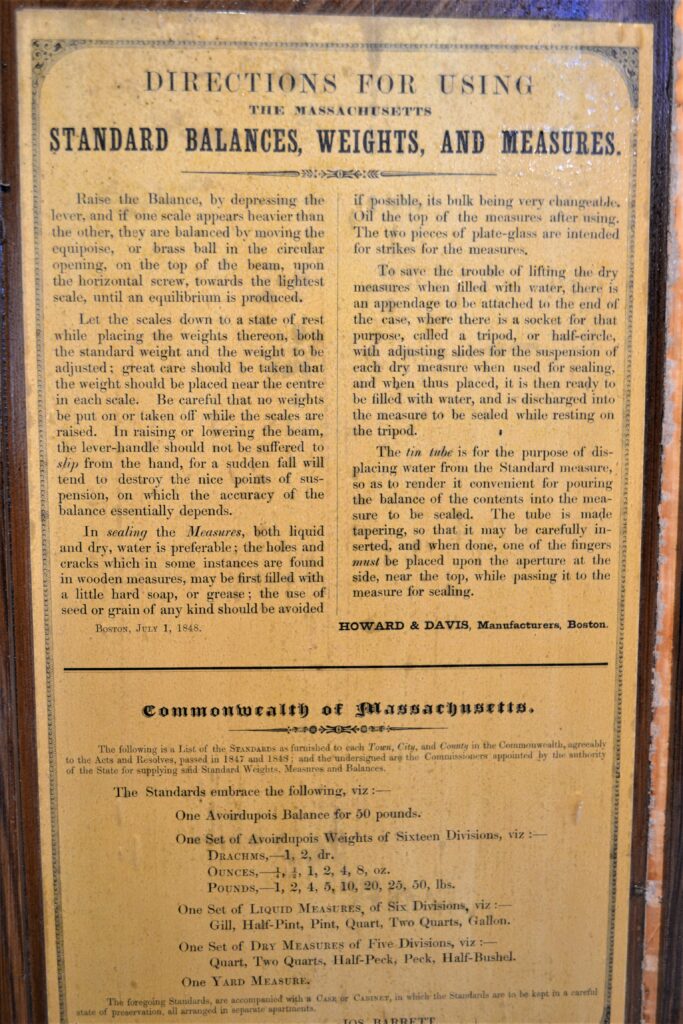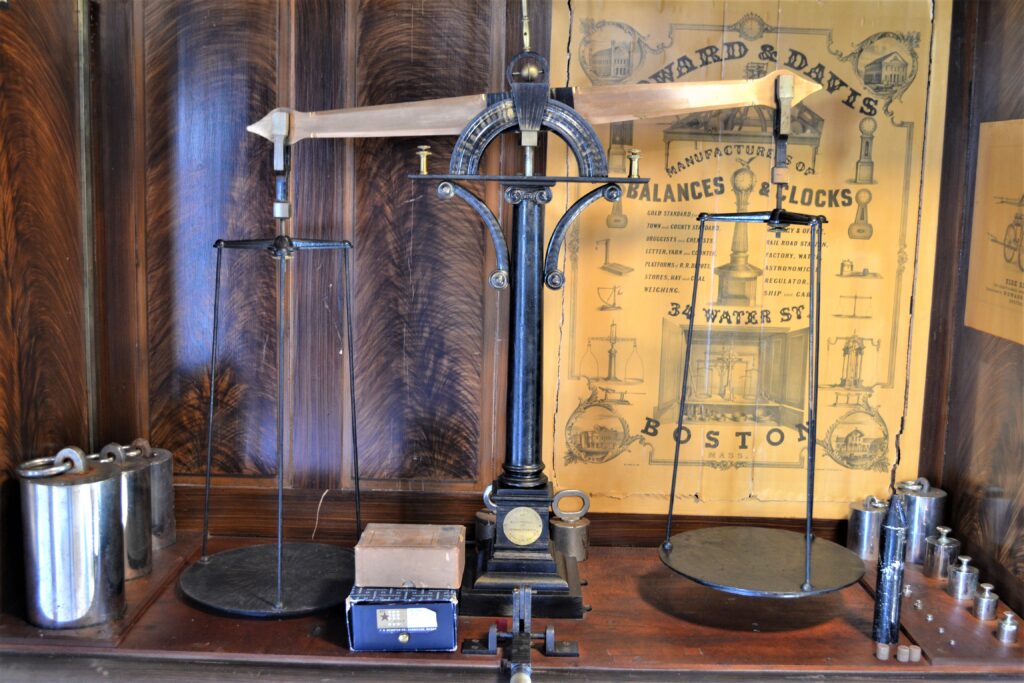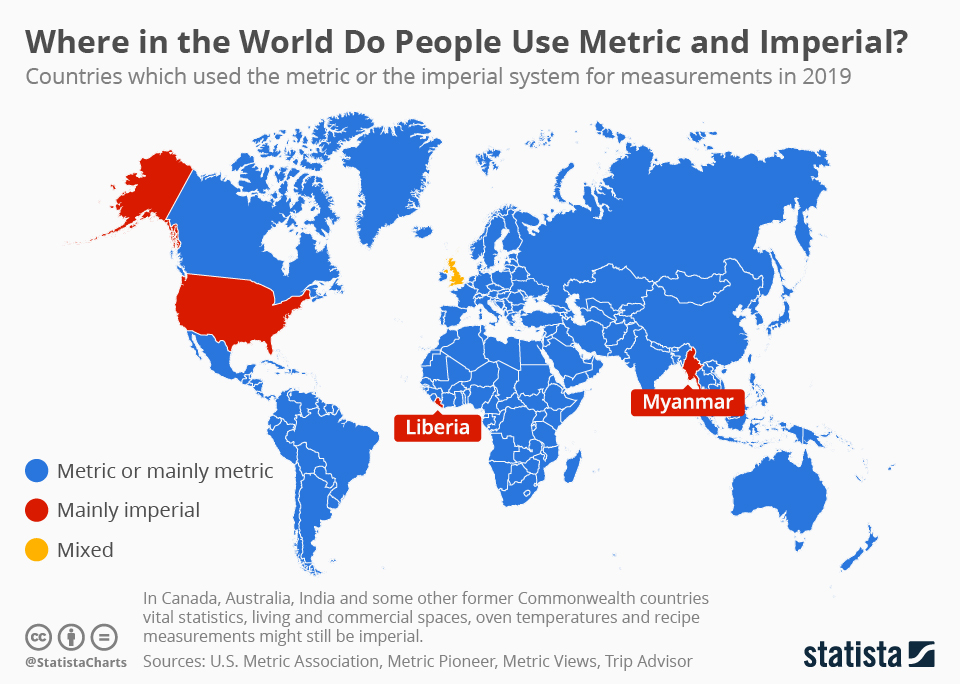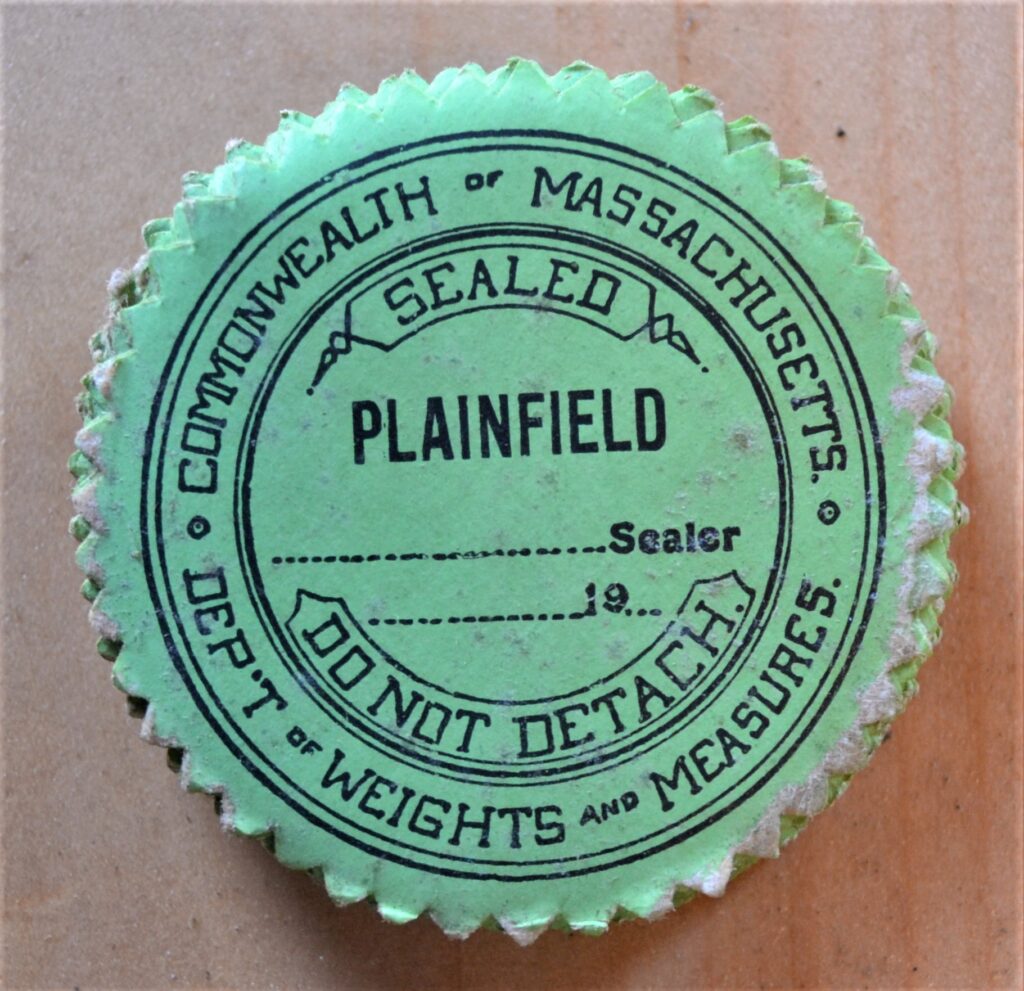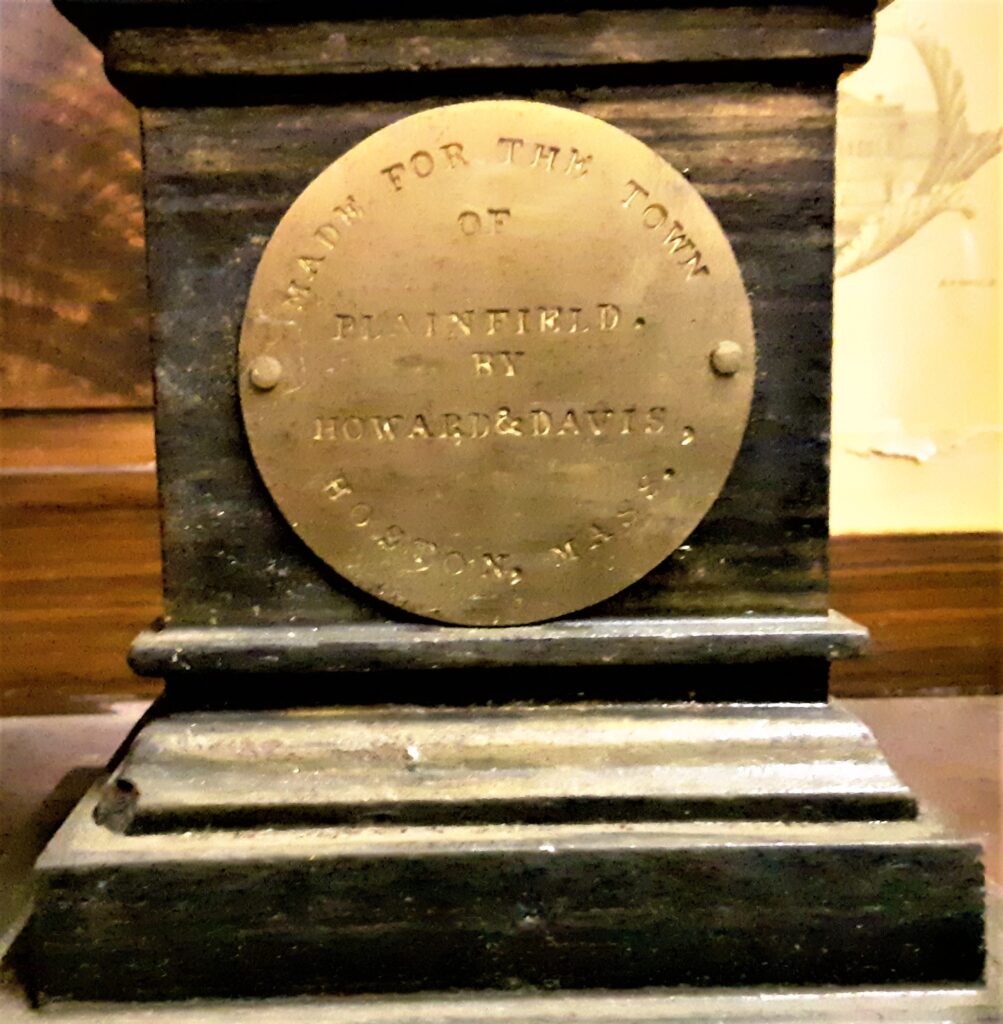The History of Weights and Measures in the United States
Last Saturday, you may have noticed a group of volunteers from town moving a rather large cabinet-like item from the Plainfield Police Station to the Shaw Hudson House and wondered, “What is that contraption?” Well, this formidable wooden behemoth is what is known as a ‘Weights and Measures’ cabinet and at one time, in the early to mid-19th century, nearly every town in Massachusetts was issued one of these. This cabinet, as do many of the artifacts from the past, speaks to an important history of our country; a history of a technology that still touches our everyday lives. From before we are born until our death and beyond, and from the center of our planet to deep space, accurate measurement is essential. Yet, most of us take for granted and seldom question how we came to decide just what is an accurate measurement. If you grocery shop, go to the doctor’s office, use tools, use modern technology, check the weather report, buy a piece of property, a bolt of fabric, mail a package, even buy a cord of wood, basically conduct any form of commerce or daily activities, you have been touched in some way by an exacting form of measurements. As in everything in our present life – there is a history behind how we got here. This blog explores that history. As always, any of the blue, highlighted words are hyperlinks that will take you to more information or resources and many of the photographs can be enlarged..
What are ‘weights and measures’?
“Weights and measures“, as used here, is actually a legal term for the uniform standards ascribed to quantity, volume, or dimensions of anything. The regulation of weights and measures is necessary for science, industry, health care and commerce. The importance of establishing uniform national standards was demonstrated by the drafters of the U.S. Constitution, who gave Congress in Article 1, Section 8, the power to “fix the Standard of Weights and Measures.” “Weights and Measures,” said John Quincy Adams in 1821, “may be ranked among the necessaries of life to every individual of human society.”
Lewis V. Judson writes, in, Weights and Measures Standards of the United States: A brief history,
“When a housewife buys a quart of milk, when a midwestern farmer sells his grain crop—in all present-day commercial transactions—there is an implied faith that as goods are exchanged for money there is the same just balance for buyer and seller. In the early days of this country such faith was often lacking. Great variation existed in the weights and measures used in different localities, and even, at times, in those used by different individuals in the same locality. The transition from this chaotic situation to the present uniformity of weights and measures has resulted from the establishment of accurate, reliable national standards of length and mass and the enactment of comprehensive weights and measures statutes. The present highly precise, and extremely stable national standards for these quantities were not achieved overnight, or even in a decade. They are the results of a long period of gradual evolution based on the dedicated efforts of men who recognized the growing need for accuracy of measurement.“
The “official” weights and measures commonly use in the colonies at the time of the American Revolution were what was being used in England at that period. The principal units were the yard, the avoirdupois pound, (a system of weight measurement based on a pound of 16 ounces or 7000 grains), the gallon, and the bushel, but surprisingly even England and France had many discrepancies in both measurement and coinage (coins needing to be exact weights of silver or gold), with many regions having different “standards.” This led to decades of confusion over fair trade pricing.
Most of the early settlers of this country brought with them the standards of weight and measure that were in use in the countries from which they came, therefore, there was little or no uniformity in their standards. As the colonies grew, both economically as well as demographically, this became a problem that affected everyone, from fair prices for agricultural goods, banking, textile measurements, to surveying of property lines.
The Founding Fathers soon realized that this was not sustainable and began to take action. Consideration was given to this subject by the Continental Congress on April 4, 1783, when a committee was appointed, consisting of Alexander Hamilton, delegate from New York, and James Madison of Virginia, eventually writing in the Articles of Confederation the following clause: “The United States in Congress assembled shall also have the sole and exclusive right and power of regulating the alloy and value of coin struck their own authority, or by that of the respective States— fixing the standard of weights and measures throughout the United States.”
In 1776 Thomas Paine wrote words that would continue to inspire future generations of Americans: “We have it within our power to begin the world anew.” This idea, that the United States had the power to reorder the world on a more rational and moral basis, would inspire many efforts at reform. One of the most interesting involved attempts to fashion a system of weights and measures appropriate to a modern society.
George Washington, in his first address to Congress, January, 1790, stated that “Uniformity in the currency, weights, and measures of the United States is an object of great importance, and will, I am persuaded, be duly attended to.”
As it is today, Congress was slow to act, and despite Washington strongly advocating for action throughout his eight years in office, little to nothing was done. Sound familiar? And while they did eventually establish some standards for money, standards for weights and measures soon became complicated. Following Washington’s suggestions however, a committee was formed in the U.S. House of Representatives and a report was submitted by then Secretary of State, Thomas Jefferson, in which he proposed two distinct plans. The first was to “define and render uniform and stable the existing system to reduce the dry and liquid measures to corresponding capacities by establishing a single gallon of 270 cubic inches and a bushel of eight gallons, or 2,160 cubic inches.” The second plan was “to reduce every branch to the same decimal ratio already established for coin, and thus bring the calculations of the principal affairs of life within the arithmetic of every man who can multiply and divide plain numbers.” Neither plan was acted on and it wasn’t until 1821, over thirty years after Washington’s request, that Congress finally acted.
“In 1819, the House of Representatives asked Secretary of State John Quincy Adams to recommend a system of measurement for the new American republic. Two years later, he issued his report, which recognized the strengths of the metric system, but recommended against it. Adams argued in behalf of the English system of weights and measures, in part because it had been perfected by hundreds of years of practical experience and partly because it used units of measurement based on the human body. An inch, Adams noted, was about the length of a knuckle; a yard represented the length of an extended arm; and a mile represented the distance the ground remained visible before it passed over the horizon (which is why a mile was sometimes called an “eye”). All that government should do, in Adams’s view, was to ensure the accuracy and uniformity of customary measurements.” – Digital History, Gilder Lehrman Institute
Report of the secretary of state, upon weights and measures, prepared in obedience to a resolution of the House of representatives of the fourteenth of December, 1819. February 22, 1821 by John Quincy Adams, Secretary of State of the United States
Still, due to complications involved in agreeing on global standards for weights and measurements, it wasn’t until June 14, 1836 that Congress passed the following resolution :
“Resolved by the Senate and House of Representatives of the United States of America in Congress assembled, That the Secretary of the Treasury be, and he hereby is, directed to cause a complete set of all weights and measures adopted as standards and now either made or in progress of manufacture for the use of the several custom-houses, to be delivered to the governor of each State in the Union, or such person as he may appoint for the use of the States, respectively, to the end that a uniform standard of weights and measures may be established throughout the United States. “
While the act does not specifically adopt the standards above described, the practical effect of it was to make them the standards for the United States, inasmuch as the weights distributed to the States in accordance with the act were in almost every case adopted the State legislatures, soon after their receipt. The act of 1836 was supplemented in 1838 by a joint resolution of Congress, which directed the Secretary of the Treasury to furnish balances to the States. By 1838 the weights for the States were reported finished, and during the following year the weights for the custom-houses were completed and delivered. By 1850, practically all the States admitted to the Union had been supplied with complete sets of weights and measures, and in addition sets were presented to England, France, Japan, and Siam. As new States were admitted they were also supplied with sets of standards, the last set being supplied to North Dakota in 1893. In order to carry out the provisions of the acts of 1836 and 1838 the Office of Weights and Measures was established to promotes uniformity in U.S. weights and measures laws, regulations, and standards to achieve equity between buyers and sellers in the marketplace.
Starting in 1848 Massachusetts issued to each city and town a Howard & Davis Weights and Measures Scale, encased in a wooden cabinet, to ensure that weights and measures were accurate and standardized throughout the state.
Contents of the Weights and Measures Cabinet
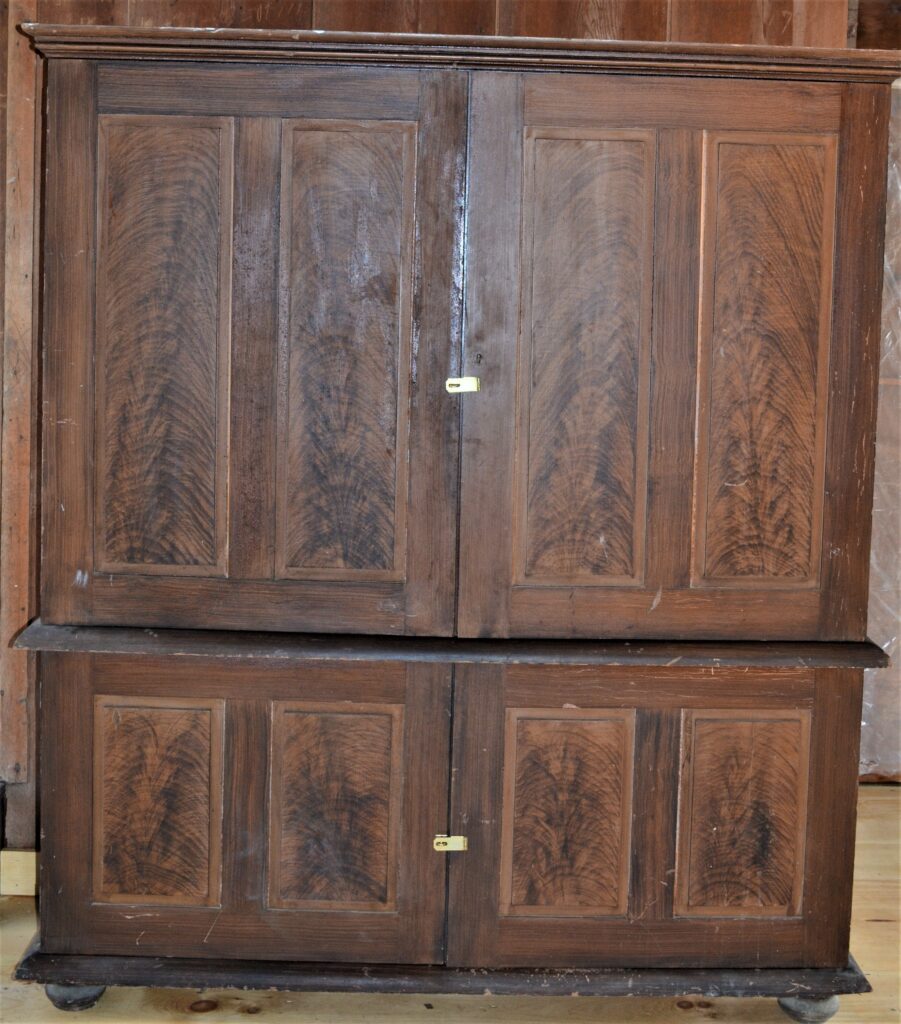
Weights and Measures cabinet. Plainfield Historical Society 
Faux grain paneled door. Plainfield Historical Society 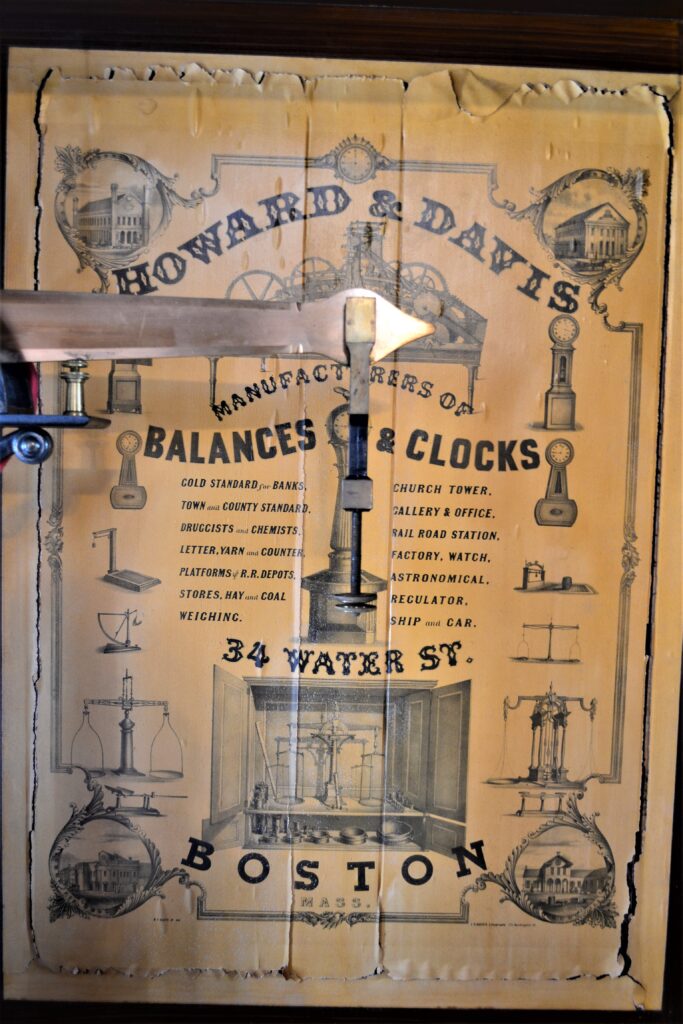
Howard & Davis Label
A complete set of standards consisted of:
• Large wooden case, with double doors on the top and bottom. Width – 64½ inches; Depth – 23½ inches; Height – 75½ inches. The top compartment containing an equal arm balance scale, set of weights and a brass linear measure (yardstick). At first, we were surprised to see that the cabinet itself was made of cheap woods but was grained to look more like an expensive wood, like mahogany. Upon researching we learned that this form of faux grain was quite common at the time, making the cabinets cheaper to produce and lighter to move.
•A cast iron column (round) with square stepped base and arched top mounted on shelf supports a 35-inch long brass beam with flat circular (12½-inch diameter) iron pans suspended from 3 rods and adjustable fork at each end of the beam.
• A lever in front of column activates the scale and sets it at rest when released. Set of 16 nickel-plated cylindrical weights, including 1 and 2 drams, ¼, ½ ,1 ,2, 4 & 8 ounces; 1, 2, 4, 5, 10, 20, 25 and 50 pounds.
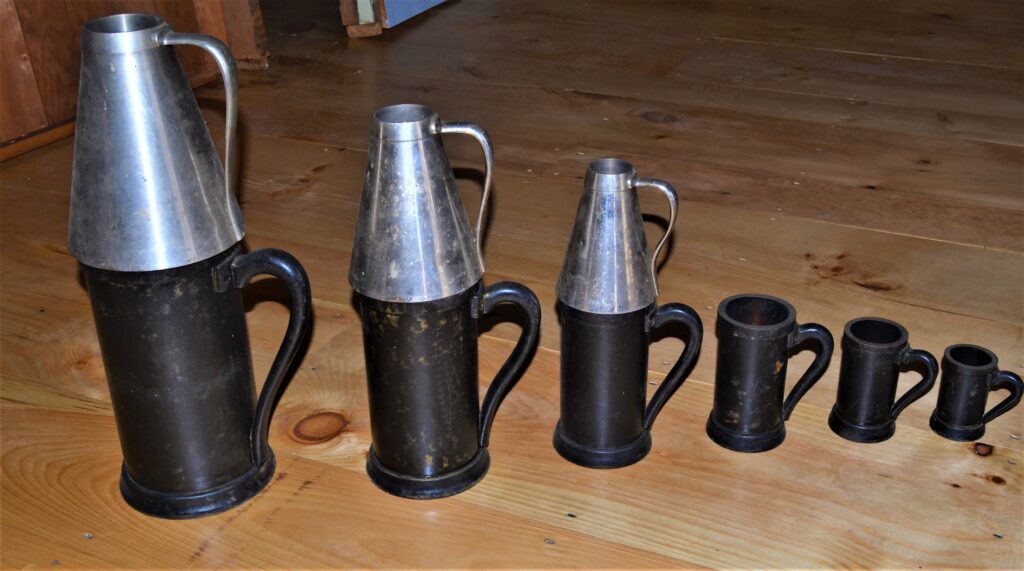
There is a set of 6 cast-iron liquid measures with handles from 1 gill to 1 gallon; a set of 5 cast iron dry measures with lugs, 1 quart to ½ bushel. A cast iron yoke with gimbals stored in the bottom cupboard can be mounted in the slot in the left end of cupboard and dry measures set into the yoke for accurate leveling.

During the nineteenth century, the Office of Standard Weights and Measures regulated measurements. In 1901 it became the National Bureau of Standards, and in 1988 it was renamed the National Institute of Standards and Technology. This agency of the Department of Commerce regulates everything from our Nation’s power grids, to electronic health records, computer chips, and infrastructure.
So Why Aren’t We Using the Metric System?
France adopted the metric system in the 1790s, starting an international movement to make the system a universal standard, replacing national and regional variants that made scientific and commercial communication difficult. Thomas Jefferson was an early advocate of the metric system and in an 1821 report to Congress, Secretary of State John Quincy Adams urged its acceptance. However, Congress stead-fastly refused.
Despite hostility to making the metric system the official U.S. system of weights and measures, its use was authorized in 1866. The United States also became a signatory to the Metric Convention of 1875, and received copies of the International Prototype Meter and the International Prototype Kilogram in 1890. In 1893 the Office of Weights and Measures announced that the prototype meter and kilogram would be recognized as fundamental standards from which customary units, the yard and the pound, would be derived.
The metric system has been adopted by many segments of U.S. commerce and industry, as well as by virtually all of the medical and scientific professions. The international acceptance of the metric system led Congress in 1968 to authorize a study to determine whether the United States should convert. Though the resulting 1971 report recommended shifting to the metric system over a ten-year period, Congress declined to pass appropriate legislation
So why hasn’t the United States totally switched over to the metric system? Decades ago, most of us were warned in grammar school that we would have to learn the metric system. So why hasn’t it changed? According to Britannica Encyclopedia:
“The biggest reasons the U.S. hasn’t adopted the metric system are simply time and money. When the Industrial Revolution began in the country, expensive manufacturing plants became a main source of American jobs and consumer products. Because the Imperial System (IS) of measurements was in place at this time, the machinery used in these factories was developed to size in IS units; all of the workers were trained to deal with IS units; and many products were made to feature IS units. Whenever the discussion of switching unit systems arose in Congress, the passage of a bill favoring the metric system was thwarted by big businesses and American citizens who didn’t want to go through the time-consuming and expensive hassle of changing the country’s entire infrastructure. Many also believed that the United States should keep its particular system, setting it apart from other countries and symbolizing its status as a leader rather than a follower.
In modern times, most have accepted a joint unit system—teaching children in school both the traditionally used IS system and the metric system that most of the rest of the world uses. This is why U.S. measuring sticks, or rulers, often contain both inches and centimeters. Unfortunately for metrics fans, widespread acceptance of joint use also means that there likely will be no official phasing out of the IS system anytime soon.”
Plainfield’s Weights and Measures cabinet in no longer in use and has spent the last 100 years in the basement of Town Hall, then moved to the Gun House, and then to the Plainfield Police Station. Finally, the cabinet has a permanent home in the newly remodeled ‘summer kitchen’ of the Shaw Hudson House. A big thanks to all the volunteers that helped us move this cabinet.
To learn more about the history of weights and measures in the United States, click on the links below.
The Meekins Library in Williamsburg has their weights and measures cabinet on display Weighed in a Just Balance Weights and Measures at Meekins Library Williamsburg, Massachusetts
Find out how the scale worked – The Westford Historical Society – Featured Artifact – Town Scale
Weights and Measures Standards of the United States Government: A Brief History by U.S. Department of Commerce
Weights and Measures in Congress By Sarah Ann Jones
History of the Standard Weights and Measurement of the United States by Louis A. Fischer
United States Standards of Weights and Measures: Their Creation and Creators by Arthur H. Frazier
United States Customary Units Wikipedia
International Metric System of Weights and Measures U.S. Department of Commerce
A Turning Point for Humanity: Redefining the World’s Measurement System NIST

